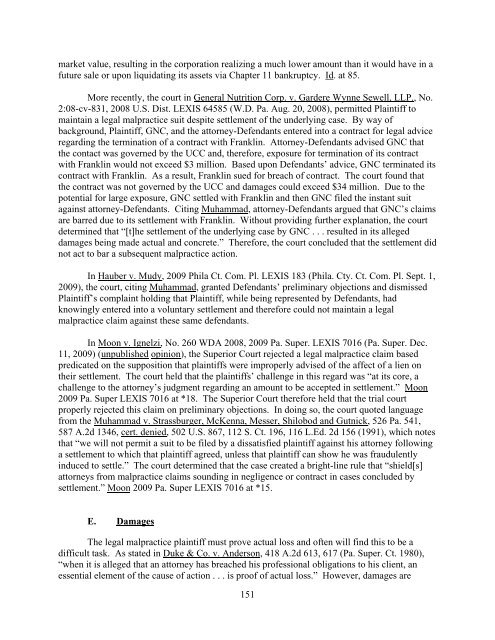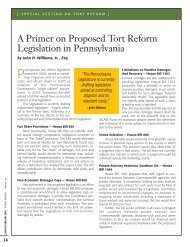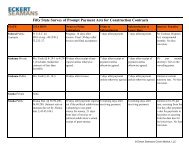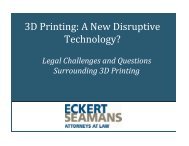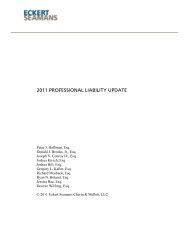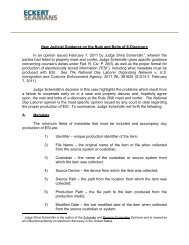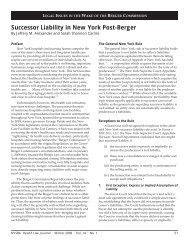decision in Muhammad precluded Mr. McMahon’s action. The majority, however, rejected thiscontention, and held that the reasoning of Muhammad has no application to these facts.Specifically, the court noted that Mr. McMahon was not attempting to attack the settlementvalue, but was alleging that his counsel failed to advise him as to the possible consequences ofentering into this settlement. Accordingly, the Court found that the analysis of Muhammad islimited to the facts of that case, and that the preliminary objections to Mr. McMahon’s actionshould have been dismissed. The concurring opinion joined the majority except to the extent thatthe majority limits Muhammad to its facts. Specifically, the concurrence emphasized that thepolicies underlying Muhammad are as necessary and valid today as they were when the decisionwas rendered five years ago and, therefore, Muhammad should not be limited to its facts.In Banks v. Jerome Taylor & Associates, 700 A.2d 1329 (Pa. Super. Ct. 1997), appealdenied, 723 A.2d 668 (Pa. 1998), the Pennsylvania Superior Court held that a negligence actionmay not be maintained against an attorney on the ground that the settlement amount obtainedwas too small. The Court reasoned that in cases where a dissatisfied litigant merely wishes tosecond guess his decision to settle in the hope that he may have been able to “get a better deal,”the Muhammad rule applies to bar that litigant from suing his counsel for negligence.Following Muhammad, in Piluso v. Cohen, 764 A.2d 549 (Pa. Super. Ct. 2000), appealdenied, 793 A.2d 909 (Pa. 2002), the Superior Court affirmed the trial court’s entry of summaryjudgment in favor of the attorney-Defendant. In the underlying medical malpractice action, theattorney had settled claims against some defendants for $100,000 and had proceeded to trial onthe claim against one remaining doctor. Plaintiff was aware of the settlement, although it hadoccurred outside her presence, and she did not repudiate it. Rather, she permitted the trial tocontinue against only the one remaining defendant. The jury returned a verdict in the amount of$1,500,000, but apportioned no liability to the sole non-settling doctor. Plaintiff thereafter filed alegal malpractice action against her attorney and claimed that she had not consented to thesettlement.Citing Muhammad, the Superior Court in Piluso held that by failing to promptlyrepudiate her attorney’s actions Plaintiff had ratified them, and was foreclosed from later filingsuit against her attorney since there was no allegation of fraud. Additionally, Plaintiff’s claimeddamages were purely speculative, as the outcome of the trial was likely to have been different ifthe settling Defendants had been present and defended the claims against them.In Red Bell Brewing Co. v. Buchanan Ingersoll, P.C., 51 Pa. D. & C. 4th 129 (Phila. Ct.Ct. Com. Pl. 2001), the Court of Common Pleas for Philadelphia County held that Muhammaddid not bar Plaintiff’s negligence action against his former attorneys where Plaintiff alleged thatDefendant-attorneys failed to provide accurate material facts on which its decisions were madeand to adequately disclose a conflict of interest between Plaintiff and one of the firm’s otherclients. The Court reasoned that the facts of Muhammad had no application to the case. Rather,the facts of the case were more similar to those in McMahon.In Capital Care Corp. v. Hunt, 847 A.2d 75 (Pa. Super. Ct. 2004), the Superior Courtapplied the rationale of Muhammad to its damage analysis to allow a corporation to prove thatthe attorney’s fraudulent misrepresentation induced it to sell its corporate assets for less than fair150
market value, resulting in the corporation realizing a much lower amount than it would have in afuture sale or upon liquidating its assets via Chapter 11 bankruptcy. Id. at 85.More recently, the court in General Nutrition Corp. v. Gardere Wynne Sewell, LLP., No.2:08-cv-831, 2008 U.S. Dist. LEXIS 64585 (W.D. Pa. Aug. 20, 2008), permitted Plaintiff tomaintain a legal malpractice suit despite settlement of the underlying case. By way ofbackground, Plaintiff, GNC, and the attorney-Defendants entered into a contract for legal adviceregarding the termination of a contract with Franklin. Attorney-Defendants advised GNC thatthe contact was governed by the UCC and, therefore, exposure for termination of its contractwith Franklin would not exceed $3 million. Based upon Defendants’ advice, GNC terminated itscontract with Franklin. As a result, Franklin sued for breach of contract. The court found thatthe contract was not governed by the UCC and damages could exceed $34 million. Due to thepotential for large exposure, GNC settled with Franklin and then GNC filed the instant suitagainst attorney-Defendants. Citing Muhammad, attorney-Defendants argued that GNC’s claimsare barred due to its settlement with Franklin. Without providing further explanation, the courtdetermined that “[t]he settlement of the underlying case by GNC . . . resulted in its allegeddamages being made actual and concrete.” Therefore, the court concluded that the settlement didnot act to bar a subsequent malpractice action.In Hauber v. Mudy, 2009 Phila Ct. Com. Pl. LEXIS 183 (Phila. Cty. Ct. Com. Pl. Sept. 1,2009), the court, citing Muhammad, granted Defendants’ preliminary objections and dismissedPlaintiff’s complaint holding that Plaintiff, while being represented by Defendants, hadknowingly entered into a voluntary settlement and therefore could not maintain a legalmalpractice claim against these same defendants.In Moon v. Ignelzi, No. 260 WDA 2008, 2009 Pa. Super. LEXIS 7016 (Pa. Super. Dec.11, 2009) (unpublished opinion), the Superior Court rejected a legal malpractice claim basedpredicated on the supposition that plaintiffs were improperly advised of the affect of a lien ontheir settlement. The court held that the plaintiffs’ challenge in this regard was “at its core, achallenge to the attorney’s judgment regarding an amount to be accepted in settlement.” Moon2009 Pa. Super LEXIS 7016 at *18. The Superior Court therefore held that the trial courtproperly rejected this claim on preliminary objections. In doing so, the court quoted languagefrom the Muhammad v. Strassburger, McKenna, Messer, Shilobod and Gutnick, 526 Pa. 541,587 A.2d 1346, cert. denied, 502 U.S. 867, 112 S. Ct. 196, 116 L.Ed. 2d 156 (1991), which notesthat “we will not permit a suit to be filed by a dissatisfied plaintiff against his attorney followinga settlement to which that plaintiff agreed, unless that plaintiff can show he was fraudulentlyinduced to settle.” The court determined that the case created a bright-line rule that “shield[s]attorneys from malpractice claims sounding in negligence or contract in cases concluded bysettlement.” Moon 2009 Pa. Super LEXIS 7016 at *15.E. DamagesThe legal malpractice plaintiff must prove actual loss and often will find this to be adifficult task. As stated in Duke & Co. v. Anderson, 418 A.2d 613, 617 (Pa. Super. Ct. 1980),“when it is alleged that an attorney has breached his professional obligations to his client, anessential element of the cause of action . . . is proof of actual loss.” However, damages are151
- Page 3 and 4:
EMTALA CASES ......................
- Page 5:
Filing an Affidavit of Non-Involvem
- Page 8 and 9:
II.PROFESSIONAL LIABILITY - AN OVER
- Page 10 and 11:
The Superior Court reversed the tri
- Page 12 and 13:
to a third party pursuant to the st
- Page 14 and 15:
After approximately five months, De
- Page 16 and 17:
learned the day after the surgery t
- Page 18 and 19:
conduct to the delay in colon cance
- Page 20 and 21:
court admitted the expert’s testi
- Page 22 and 23:
(b)(c)other reasonable causes, incl
- Page 24 and 25:
corroborated his testimony. The cou
- Page 26 and 27:
husband’s estate. Plaintiff alleg
- Page 28 and 29:
Other notable federal cases arising
- Page 30 and 31:
The Superior Court found that in re
- Page 32 and 33:
§ 1303.512(b). The court, however,
- Page 34 and 35:
In Neidig v. United States, No. 07-
- Page 36 and 37:
Additionally, the Supreme Court not
- Page 38 and 39:
were not indicated for her conditio
- Page 40 and 41:
surgeon is the same as it would be
- Page 42 and 43:
It should be noted that the Superio
- Page 44 and 45:
Finally, the court held that the tr
- Page 46 and 47:
The Supreme Court of Pennsylvania r
- Page 48 and 49:
nurses deviating from applicable st
- Page 50 and 51:
certainty, the court reviews expert
- Page 52 and 53:
Under Pennsylvania law, the Court n
- Page 54 and 55:
testimony, Defendant presented his
- Page 56 and 57:
Following Cooper v. Roberts, 286 A.
- Page 58 and 59:
Plaintiff developed chronic diarrhe
- Page 60 and 61:
where payment is made by Medicaid w
- Page 62 and 63:
accomplished. In Valles v. Albert E
- Page 64 and 65:
In 1980, the Pennsylvania Superior
- Page 66 and 67:
Plaintiff had a routine monitoring
- Page 68 and 69:
Plaintiff’s Contract ClaimsThe Co
- Page 70 and 71:
is a failure to report changes in a
- Page 72 and 73:
unit to assure post-surgical patien
- Page 74 and 75:
sliced his wrist and arm with a raz
- Page 76 and 77:
licensed professionals for whom the
- Page 78 and 79:
(c)Limitations of Corporate Neglige
- Page 80 and 81:
Even more recently, our Superior Co
- Page 82 and 83:
(a)HMO IssuesIn McClellan v. Health
- Page 84 and 85:
affidavit submitted by Defendants o
- Page 86 and 87:
treatments while at VA’s faciliti
- Page 88 and 89:
[s]ubstantively, we believe that a
- Page 90 and 91:
The party claiming the benefit of t
- Page 92 and 93:
deprive (him) of civil rights guara
- Page 94 and 95:
found that the District Court was w
- Page 96 and 97:
With respect to fraudulent concealm
- Page 98 and 99:
would be applied in situations wher
- Page 100 and 101:
they had not raised them in the cou
- Page 102 and 103:
(a)Informed ConsentUnder MCARE, a p
- Page 104 and 105:
civil enforcement provisions and ma
- Page 106 and 107: MCARE also changes the manner in wh
- Page 108 and 109: whose death, in 2005, was allegedly
- Page 110 and 111: vicariously liable if the plaintiff
- Page 112 and 113: health center or its equivalent or
- Page 114 and 115: In Pennsylvania Medical Society, th
- Page 116 and 117: to any professional who is alleged
- Page 118 and 119: Since the 2005 amendments, there ha
- Page 120 and 121: ule, but who intentionally ignores
- Page 122 and 123: the original Complaint was delivere
- Page 124 and 125: foreclose all challenges against th
- Page 126 and 127: number of boxes), which was support
- Page 128 and 129: questions of professional judgment
- Page 130 and 131: deviated from any professional stan
- Page 132 and 133: The Third Circuit affirmed the Dist
- Page 134 and 135: claims and cross-claims remain agai
- Page 136 and 137: By an Amendatory Order dated March
- Page 138 and 139: The court acknowledged that there i
- Page 140 and 141: apply and that the trial court misa
- Page 142 and 143: Barbados had enough litigation-spec
- Page 144 and 145: E. Preemption of Vaccine Design Def
- Page 146 and 147: 2. Pa. R. Civ. Pro. 1036.1 - Reinst
- Page 148 and 149: Barrick, at *34-35.Furthermore, the
- Page 150 and 151: (b) the utility of the defendant’
- Page 152 and 153: 2006). In this case, Plaintiffs bro
- Page 154 and 155: B. Elements of a Cause of Action fo
- Page 158 and 159: considered speculative “only if t
- Page 160 and 161: underlying cause of action involved
- Page 162 and 163: In Capital Care Corp., the Superior
- Page 164 and 165: The court found, however, to state
- Page 166 and 167: of reasonable diligence. The standa
- Page 168 and 169: not be set aside. On July 7, 2005,
- Page 170 and 171: complete bar to recovery. Since a l
- Page 172 and 173: On appeal, Plaintiffs claimed that
- Page 174 and 175: In Liggon-Redding, 659 F.3d at 265,
- Page 176 and 177: elieved of those minimum standards
- Page 178 and 179: elevant to the proceedings, the com
- Page 180 and 181: establish professional misconduct b
- Page 182 and 183: Upholding the Superior Court’s Or
- Page 184 and 185: Id.Rejecting revocation and suspens
- Page 186 and 187: order as a sanction under Rule 4019
- Page 188: {1009912]182


